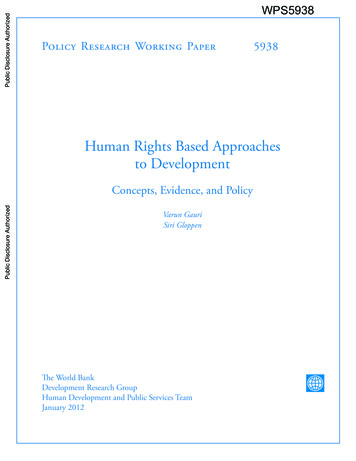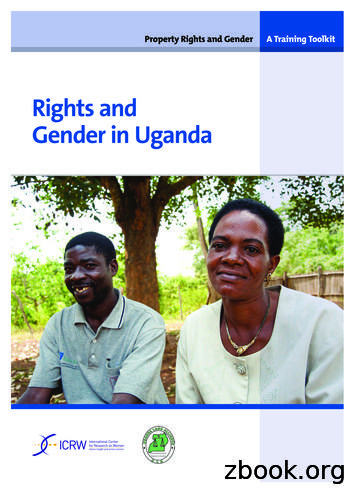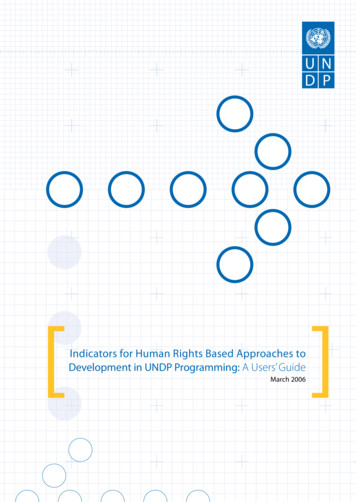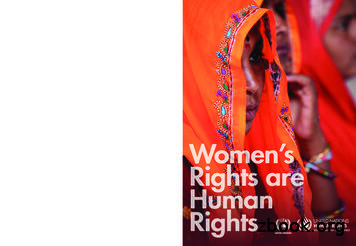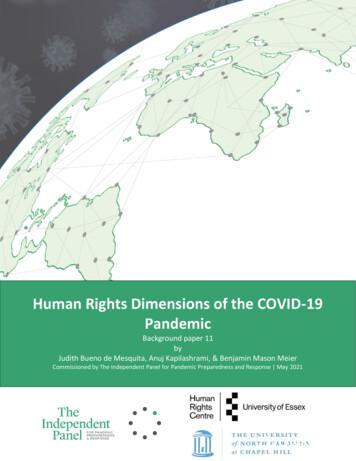Human Rights Based Approaches To Development
Public Disclosure AuthorizedPublic Disclosure AuthorizedPublic Disclosure AuthorizedPublic Disclosure AuthorizedWPS5938Policy Research Working Paper5938Human Rights Based Approachesto DevelopmentConcepts, Evidence, and PolicyVarun GauriSiri GloppenThe World BankDevelopment Research GroupHuman Development and Public Services TeamJanuary 2012
Policy Research Working Paper 5938AbstractThis paper assesses the benefits, risks, and limitationsof human rights based approaches to development,which can be catalogued on the basis of the institutionalmechanisms they rely on: global compliance based oninternational and regional treaties; the policies andprogramming of donors and executive agencies; rightstalk; and legal mobilization. The paper briefly reviewsthe politics of the first three kinds of human rights basedapproaches before examining constitutionally basedlegal mobilization for social and economic rights ingreater detail. Litigation for social and economic rightsis increasing in frequency and scope in several countries,and exhibits appealing attributes, such as inclusivenessand deliberative quality. Still, there are potential problemswith this form of human rights based mobilization,including middle class capture, the potential countermajoritarianism of courts, and difficulties in compliance.The conclusion summarizes what is known, and whatremains to be studied, regarding human rights basedapproaches to development.This paper is a product of the Human Development and Public Services Team, Development Research Group. It is partof a larger effort by the World Bank to provide open access to its research and make a contribution to development policydiscussions around the world. Policy Research Working Papers are also posted on the Web at http://econ.worldbank.org.The authors may be contacted at vgauri@worldbank.org or siri.gloppen@cmi.no.The Policy Research Working Paper Series disseminates the findings of work in progress to encourage the exchange of ideas about developmentissues. An objective of the series is to get the findings out quickly, even if the presentations are less than fully polished. The papers carry thenames of the authors and should be cited accordingly. The findings, interpretations, and conclusions expressed in this paper are entirely thoseof the authors. They do not necessarily represent the views of the International Bank for Reconstruction and Development/World Bank andits affiliated organizations, or those of the Executive Directors of the World Bank or the governments they represent.Produced by the Research Support Team
Human Rights Based Approaches to Development:Concepts, Evidence, and PolicyVarun Gauri and Siri Gloppen1JEL: K32, K33, K40Keywords: Human rights, international law, constitutions, development policy, socialpolicySector board: Public Sector Management1Varun Gauri is Senior Economist at the World Bank; Siri Gloppen is Professor of Comparative Politics at theUniversity of Bergen. For their comments and guidance, the authors thank the members of the American PoliticalScience Association Task Force on Democracy, Economic Security, and Social Justice in a Volatile World,especially Michael Goodhart.
Human rights are probably the dominant normative conception in the contemporaryglobalized world. It is common for struggles for national self-determination, the recognition ofalternative identities, class-based and labor empowerment, gender equality, democratic inclusion,property rights protections, rectification of state violence, and consumer goods to use rightsdiscourse – in spite of varying political orientations and alliances among the actors involved.Development is no exception. Whereas it was understood primarily in the terms of economicoutput from about 1950 to 1970, and concerned with poverty from around 1970 to 1990,development has in the past two decades increasingly been framed in the language of humanrights and related concepts, such as fundamental human capabilities and multi-dimensionalpoverty. The objectives for doing so, on the part of advocates, have been, broadly speaking, tocharacterize the elimination of extreme poverty as a moral imperative, and to underscore that thekind of political power associated with the assertion of claims by the poor themselves is aprerequisite to the elimination of extreme poverty. The first point is commonly thought of asspeaking to the ―intrinsic‖ dimension of human rights, and the latter to their ―instrumental‖dimension.The intrinsic dimension is instrumentally useful, however, if it mobilizes rich countrygovernments and citizens, as well as the privileged citizens of developing countries, to contributemore resources to development, and to do so more effectively. So perhaps it is better to say thatthere are aspects of human rights based approaches to development (HRBAs) that target dutybearers by raising the moral pressure, and other aspects that target rights-holders by instilling thedignity and self-respect necessary for political, social, and legal mobilization; and that both can,arguably, reduce poverty and inequality at the global and national levels. In other words, HRBAswork both on the supply and demand sides of development.2
Although HRBAs have been widely discussed and used, definitions vary; and there isnot, to our knowledge, an authoritative source. For our purposes, we define HRBAs as principlesthat justify demands against privileged actors, made by the poor or those speaking on theirbehalf, for using national and international resources and rules to protect the crucial humaninterests of the globally or locally disadvantaged. Note that this account takes sides on some ofthe semantic controversies surrounding human rights: it does not distinguish between so-called―positive‖ (economic, social, and cultural) rights and ―negative‖ (civil and political) rights,merely noting that both may involve crucial interests; nor does it restrict the targets of humanrights claims to states or governments, leaving open the idea that individuals, firms, and otherprivate actors may be duty-bearers.The definition is also narrower than most accounts of rights claims. More particularly,this definition of HRBAs (i) does not include the rights of the relatively well-off, focusinginstead on poverty; and (ii) emphasizes resources and regulation rather than the moreinteractional duties that arise from the natural law and natural rights traditions. (It is for thisreason that we refer, in this paper, to ―human rights based approaches,‖ rather than the morewidely used phrase ―rights based approaches‖ to development.) HRBAs, moreover, do notsubsume the various other social practices and rules that underpin political morality, socialstability, and modern economic growth. HRBAs may include principles by which these otherinstitutions and rules systems might be evaluated; but HRBAs cannot construct all socialprinciples from the ground up, as they leave out many obvious and important elements of socialorganization. For these reasons, and probably others as well, it would be a mistake to equateHRBAs with more encompassing accounts of social justice or social change. In particular, weunderstand HRBAs to be targeted interventions on the part of governments and donors; and we3
distinguish them from broader transformations in state-society relations, such as democratizationor the creation of ―open access orders‖(North, Wallis, and Weingast 2009), that have largeeconomic repercussions.So far, we have said little about what kinds of institutions HRBA principles speakthrough. We have left the definition deliberately open because HRBAs entail various kinds of―mechanisms.‖ For instance, HRBAs sometimes entail persuading states to ratify and then liveup to international and regional human rights treaty commitments, enhancing a variety ofaccountability oriented institutions in governments and donors (e.g., human rights commissions,ombudsmen, agencies of administrative redress), persuading citizens to think of themselves asrights-holders through civil society-based rhetoric, and employing legal mobilization in nationalcourts.2 In a given country, HRBAs might employ any combination of these ―mechanisms,‖ andthe quality of the institutions sustaining these sub-approaches varies significantly, even within agiven country. As a result, it is difficult to demarcate the boundaries of an HRBA in a givencontext, and to identify its contribution to development in isolation from the institutions it relieson. The approach we take here, therefore, is analytic rather than strictly empirical. Wedifferentiate HRBAs on the basis of four analytic components: HRBAs rooted in internationaland regional treaties, policies and principles of donors and executive agencies, normative beliefs,and constitutional rights. We try to assess the prospects for each on the basis of extant researchon the channels through which they are likely to operate. (But although we isolate them foranalytic purposes, these components rely on and activate each other.) In the remainder of this2For descriptions of HRBAs or RBAs, see Banik, Dan 2010. Poverty and elusive development:Universitetsforlaget., Uvin, P. 2004. Human rights and development: Kumarian Pr., OHCHR, Office of the HighCommissioner for Human Rights. 2006. Frequently asked questions on a human rights-based approach todevelopment cooperation: United Nations Pubns., Jonsson, Urban. 2005. "A human rights-based approach toprogramming." Reinventing Development:47-62., Darrow, Mac and Amparo Tomas. 2005. "Power, capture, andconflict: a call for human rights accountability in development cooperation." Human Rights Quarterly 27:471-538.4
paper, we briefly review the first three kinds of HRBAs before characterizing thejudicial/constitutional mode in greater detail.Global ComplianceThe UN Office of the High Commissioner for Human Rights names nine coreinternational human rights treaties: the International Convention on the Elimination of All Formsof Racial Discrimination, 1965; the International Covenant on Civil and Political Rights, 1965;the International Covenant on Economic, Social and Cultural Rights, 1966; the Convention onthe Elimination of All Forms of Discrimination Against Women, 1979; the Convention againstTorture and other Cruel, Inhuman or Degrading Treatment or Punishment, 1984; the conventionon the Rights of the Child, 1989; the International Convention on the Protection of the Rights ofAll Migrant Workers and Members of Their Families, 1990; the International Convention for theProtection of All Persons from Enforced Disappearance, 2006; and the Convention on the Rightsof Persons with Disabilities, 2006.3 There are also several Optional Protocols attached to thesetreaties, and the several regional treaties with human rights components (along with theiramendments), such as the European Social Charter, 1961; the American Convention on HumanRights, 1978; and the African Charter on Human and Peoples‘ Rights, 1981. It is often said thatthese various instruments are grounded, for purposes of interpretation and inspiration, in theUniversal Declaration of Human Rights, 1948.One analytic component of HRBAs pressures states to ratify these regional andinternational instruments, and uses the fact of ratification to hold states to account for thedelivery of increased and higher quality development assistance. This holding to account can3See http://www2.ohchr.org/english/law/.5
take both legal and political forms, and can operate both on rich country governments and ondeveloping country governments. When first conceived in the mid to late 1940s, the internationalhuman rights regime was intended to operate juridically (Beitz 2009; Glendon 2002). Treatybodies would hear complaints against UN member states in a court-like setting, and they wouldissue opinions that would be binding, from the point of view of international law. Theeffectiveness of human rights courts at the international level is somewhat mixed (Helfer andSlaughter 1997b; Voeten 2008).The juridical model has had very limited impact in motivating rich country governmentsto increase the quantity or quality of development assistance. As a textual matter, none of thecore international human rights treaties establishes obligations of development assistance on thepart of rich country governments, and a draft of an international instrument related to the Rightto Development has languished without much prospect of achieving approval by the GeneralAssembly.4 Quasi-juridical modes of development review, such as the World Bank‘s InspectionPanel, have reoriented or blocked development projects in new cases; but neither the WorldBank nor the IMF is bound by international human rights treaties, and complaints that have beenlodged have almost entirely focused on acts of commission rather than omission.5As contributors to political mobilization, however, human rights treaties may bebeginning to play a role in pressuring rich country governments to increase the quantity andquality of development assistance. Pogge (2002) and others have argued human rights demand a4The Declaration on the Right to Development was adopted by the UN General Assembly in 1986; and whileproponents have attempted to put together a binding international instrument, that effort has not succeeded. For thetext see http://www2.ohchr.org/english/law/rtd.htm. For a history and analysis see Sengupta, Arjun. 2002. "On theTheory and Practice of the Right to Development." Human Rights Quarterly 24:837-889.5An exception is the recent World Bank Inspection Panel case on the Land Management and Administration Projectin Cambodia, Request RQ 09/08. Documentation is available NSPECTIONPANEL/0,,contentMDK:22326773 menuPK:64129250 pagePK:64129751 piPK:64128378 theSitePK:380794 isCURL:Y,00.html6
reform of the international aid architecture, as well as of international trade, carbon emissions,tax policies, and intellectual property regimes. While it is possible to ground such rules inArticle 28 of the UDHR, which states that ―Everyone is entitled to a social and internationalorder in which the rights and freedoms set forth in this Declaration can be fully realized,‖ thatprovision, to date, typically plays a stronger role in motivating activism than structuring stateparty negotiations regarding international regime design.At the regional level, quasi-juridical human rights treaty bodies have made significantrulings in a number of cases (Langford 2008a; Langford 2008b). The numbers of rulings relatedto development are relatively small (the Inter-American Court of Human Rights had issued some92 opinions in 2009), and partial or non-compliance are more common than full compliance(Hawkins and Jacoby 2008). The basic problem remains that of the absence of a politicalauthority above states, or international anarchy, which neo-realists emphasize (Krasner 1993).The strongest effects of international human rights treaties are expected to be visible atthe national, rather than the international or regional, levels. The literature has developed anapproach to human rights treaty compliance that Simmons (2009:125) calls a ―domestic politicstheory of treaty compliance.‖ In that approach, compliance requires domestic pressure on thegovernment. The pressure might take the form of NGO- and civil society-initiated mobilizationon behalf of treaty goals, the judicial application of treaties and the human rights normsembedded in them to domestic settings, or the empowerment of elements of the executive whosegoals are consistent with treaty objectives.The empirical record of the effects of treaty ratification on human rights outcomes at thenational level remains mixed. Hafner-Burton (2008) finds that the presence of NGOs isassociated with (incomplete and transient) compliance with treaties in the area of political rights.7
Neumayer (2005) finds that civil society strength increases the likelihood of compliance withhuman rights treaties. Helfer and Slaughter (1997a) argue that supranational adjudication ofhuman rights treaties in Europe empowered domestic courts and individuals in particularcountries. Powell and Staton (2009) argue that the effectiveness of the domestic legal regimeconstrains states‘ choices to violate human rights. Moravcsik argues that treaty effects areconditional on the relative strength of domestic political actors (political parties, NGOs, andothers), who in liberal democratic regimes support the treaty goals (Moravcsik 1997). (Gauri2011) contends that ratification of the CRC was correlated with a subsequent increase inimmunization rates, but only in upper middle and high income countries. Helfer documents howthe ―overlegalization‖ of the human rights regime led Caribbean governments to opt out of treatyagreements and resulted, in some cases, in worse human rights outcomes (Helfer 2002).Hathaway finds that ―state expressions of commitment to human rights through treaty ratificationmay sometimes relieve pressure on states to pursue real changes in their policies and therebyundermine the instrumental aims of those very same treaties.‖ (Hathaway 2002) Simmons (2009)is probably the most optimistic, finding that treaty ratification was associated with betterperformance on child labor and gender equality. Overall, however, the empirical work on thecontemporaneous effects of treaty ratification on development outcomes is relatively limited, andthe findings mixed.Constructivists, however, argue that over longer time periods debates surrounding humanrights can change identities, interests, and preferences in such a way that government leaders andcitizens begin to embrace human rights norms. The processes through which these changeinclude NGO pressure and transnational advocacy that eventually lead governments to movefrom repressing human rights movements to endorsing them, often by enhancing the stature of8
reformers in the coalition (Risse, Ropp, and Sikkink 1999). (This suggests that someconstructivist accounts are not inconsistent with domestic mobilization explanations.) On theother hand, the processes can be more sociological in nature, involving personal and institutionalinteractions that lead particular interpretations of human rights norms to be internalized (Koh1999), or peer influences to affect observable behavior through processes of acculturation(Goodman and Jinks 2005).In summary, theory suggests that treaty-based HRBAs are more likely to achieve―enforcement‖ or ―compliance‖ at the national level through domestic political mechanisms,such as civil society organizations, courts, and bureaucratic entrepreneurs, than at theinternational or regional levels through quasi-juridical enforcement. The evidence to dateindicates that treaties can have some limited direct, contemporaneous impact on developmentoutcomes. It is likely that treaties have more long-term effects on development policies throughconstructivist channels; but more empirical work along these lines remains to be done.Policies and ProgrammingA number of international and bilateral development agencies have endorsed a humanrights orientation in the provision of health care and education in developing countries.6 Thenotion of rights as high priority goals is implicit in some of the legal documents underlying therights approach to development. The WHO Constitution, 1946, and the Declaration of Alma Ata,6See, for example, DFID, Department for Internatinal Development. 1997. "Realising human rights for poorpeople.", UNDP, United Nations Development Program. 2000. Human Development Report. New York: OxfordUniversity Press, UNESCO, United Natinos Educaitonal, Scientific, and Cultural Organization. 2000. WorldEducation Report 2000: The Right to Education: Towards Education for All Throughout Life. Paris: Unesco.Summary reviews are Hamm, B.I. 2001. "A human rights approach to development." Human Rights Quarterly23:1
Human rights and development: Kumarian Pr., OHCHR, Office of the High Commissioner for Human Rights. 2006. Frequently asked questions on a human rights-based approach to development cooperation: United Nations Pubns., Jonsson, Urban. 2005. "A human rights-based approach to programming." Reinventing Development
Rights and gendeR in Uganda · 3 Rights & Human Rights Background Rights The law is based on the notion of rights. Community rights workers need to understand what rights are, where rights come from, and their own role in protecting and promoting rights. Community rights worker
stream human rights into development projects and to monitor and implement a human rights-based approach (HRBA) to development more generally. From the side of human rights, the demand has come from recognition among the human rights treaty monitoring bodies, the Office of the High Commissioner for Human Rights, and a variety of Special .
A Human Rights Perspective by David Shiman Raising Children with Roots, Rights and Responsibilities: Celebrating the UN Convention on the Rights of the Child by Lori DuPont, Joanne Foley, and Annette Gagliardi Lesbian, Gay, Bisexual, and Transgender Rights: A Human Rights Perspective by David M. Donahue The Human Rights Education Handbook:
make up the International Bill of Human Rights. The provisions of the two Covenants, as well as other human rights treaties, are legally binding on . of their human rights, for example marriage and the family. 6 WOMEN’S RiGHTS ARE HUMAN RiGHTS The Convention defines d
human rights impact of COVID-19 and COVID-19 responses on human rights; the role of global health and human rights governance actors, including the WHO, World Health Assembly, Office of the High Commissioner for Human Rights and UN human rights oversight bodies, suggesting areas of action for
FROM PRINCIPLE TO PRACTICE 03 Part 1 Introduction 05 1.1 Overview 1.2 About the Victorian Charter of Human Rights and Responsibilities 1.3 The human rights based approach Part 2 The case for a human rights based approach 07 2.1 The legal case 2.2 The practice case Part 3 Understanding the human rights based approach 11
"The issue of terrorism is not new on the human rights agenda. Terrorism is a threat to the most fundamental human rights. Finding common approaches to countering terrorism serves the cause of human rights. Some have suggested that it is not possible to effectively eliminate ter - rorism while respecting human rights. This suggestion is
NuClear News No. 42 July 2012 2 projects director Jeremy Western says there are still three areas where the government needs to do more work: creating a “tangible counterparty” to sign contract for difference feed in tariffs (CFD Fits); ensuring the transitional agreements are legally robust and ensuring EMR reaches Royal Assent in spring .
